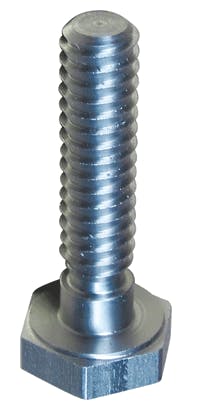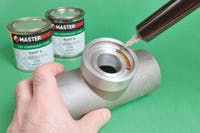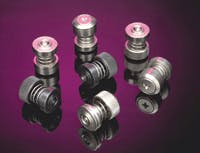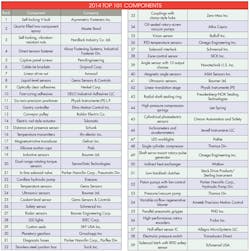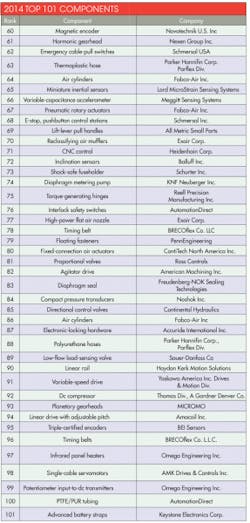This file type includes high-resolution graphics and schematics when applicable.
We post these products on http://machinedesign.com and promote them in e-mail newsletters, tracking reader interest via Web-site analytics. Here, we list those that attracted the most interest.
With all the hype that surrounds today’s flashy electronics and high-tech software, it might be a bit surprising that the top vote getters were less-glitzy fasteners and adhesives. Obviously, regardless of the type of device or machine, today’s mobile and industrial equipment must be durable and reliable despite extreme loads, shock and vibration, and harsh operating environments. That starts with how structural members and individual components are held together.
Bolt claims top spot
A new self-locking V-bolt from Asymmetric Fasteners, Hackettstown, N. J., eliminates the need for additional locking hardware, applies high clamping force, and reportedly offers reliable, vibration-resistant fastening. The V-bolt works with standard 60° female threads and spins freely until clamp load is applied. As the clamp load increases, locking action takes place around the entire circumference of thread engagement. Available sizes range from 6-32 to ½-13.
Super epoxy takes second place
Thermally stable Supreme 45HTQ is a high-strength, two-component quartz-filled epoxy with exceptional abrasion and chemical resistance. Made by Master Bond, Hackensack, N. J., it bonds well to metals, composites, ceramics, and many rubbers and plastics, and withstands exposure to petrochemicals, acids, bases, and solvents.
Tensile strength exceeds 10,000 psi and compressive strength is greater than 20,000 psi at room temperature. The epoxy has a 100:30 mix ratio by weight and offers a 12‑hr+ working life at room temperature. With good flow properties, it applies easily for bonding and sealing, and can be cast in sections several inches deep. Dimensionally stable, it requires oven curing at 250 to 350°F with low shrinkage upon curing. As a toughened compound, Supreme 45HTQ resists rigorous thermal cycling and performs well at temperatures up to 450°F.
Vibration-resistant nuts
In the third spot are Hardlock nuts — self-locking, vibration-resistant nuts from Hardlock Industry, Elk Grove Village, Ill. To prevent the nuts from loosening, a centered concave top nut and off-center (eccentric) convex lower nut combine to form a wedge when tightened. This applies force perpendicular to the bolt. When the top and bottom nuts are tightened, the self-locking force of the wedge prevents loosening, even when subjected to repeated vibrations and shock. They’re available in a range of inch sizes to 1-in. UNC and metric sizes to M64.
More fasteners
Two other mechanical fasteners made the top-10 list. One is the Huck BobTail direct-tension fastener made by Alcoa Fastening Systems, Waco, Tex. It reportedly combines high strength, reliability, and excellent corrosion resistance, due to its no-break-off pintail design. The fasteners resist vibration and have five times the fatigue strength of conventional nuts and bolts. The BobTail’s low-swage technology permits speedy installation (under 2 sec/fastener) with lightweight, ergonomic tooling. The units come in steel, aluminum, and stainless steel in round, truss, 90°, flush, flanged, and 98T head styles, in a range of inch and metric sizes.
Captive panel screws from PennEngineering, Danboro, Pa., also had high interest from our readers. PEM Types PF50 and PF60 self-clinching captive panel screws permanently mount in thin metal assemblies (0.30 in./0.8 mm). Integrating the captive screw in a spring-loaded assembly makes for easy and efficient handling and installation and eliminates lost or misplaced hardware. A low-profile design minimizes protrusion on front panels — only 0.34 in. from the top of the sheet.
They tighten or loosen using a Phillips screwdriver. Multiple screw lengths with thread sizes from #4-40 through ¼-20 and M3 through M6 are available. They can be engineered with MAThread anticross-threads and customized with a scratchproof DuraBlack finish.
Cable-tie brackets
Sometimes, simple designs are best. Pneumatically “nailed” TackMounts secure cables, tubing, and wiring-harnesses in many different applications. The brackets are said to be more permanent than adhesive-bonded versions and faster, safer, and cleaner than drilling holes for conventional hardware. TackMounts are made of high-strength, impact-resistant polyamide (nylon) with a built-in hardened-steel MetalTack that securely nails into virtually any metal surface. The brackets rotate in place for final alignment making harnessing tasks a snap. They’re made by Gripnail, East Providence, R. I.
Linear-drive nut
When it comes to durability and simplicity, mechanical drives are often hard to beat. The Model RS rolling-ring linear-drive family, from Amacoil, Aston, Pa., now includes the RS8 drive nut. The new nut drive runs on an 8-mm-diameter, case-hardened and ground, smooth shaft with no threads to trap debris and cause clogs or jams, providing built-in overload protection. Drive-system components are protected from possible damage from the churning and grinding that sometimes occurs with other linear drives, eliminating downtime for cleaning threads and making repairs.
The RS8 has an extruded aluminum-profile housing and features zero-backlash linear motion because the inner race of each rolling-ring bearing is in constant point-contact with the shaft. Ten RS drive-nut models are available, each with a different axial-thrust capacity.
Sending data to a controller from various points on a machine — for tasks ranging from positioning control to condition monitoring — has grown critical in many applications. That’s why various types of sensors, transducers, transmitters, and encoders were the top product grouping — accounting for 30 of the Top 101 components.
Cracking the top-10 list were CAP-100 Series capacitive liquid-level sensors made by Gems Sensors & Controls, Plainville, Conn. They provide accurate level sensing through the walls of plastic, glass, and fiberglass bottles and reservoirs with wall thicknesses to 0.39 in. (10 mm). The sensors are suitable for medical applications such as waste, reagent, buffer, or diluent as well as dark, sticky, or viscous fluids.
The easy-to-calibrate sensors detect both aqueous and nonaqueous liquids and can be used as proximity sensors to detect the presence of solids. The units come with a choice of wet or dry-sink switch actuation, have IP67 protection, and incorporate LED signal and power indicators with a potentiometer for sensitivity-field adjustments.
More adhesives
More adhesives round out the top-10 list. Liquid optically clear adhesives (LOCAs) made by Henkel Corp., Rocky Hill, Conn., are for bonding cover lenses and displays. Loctite 3191, 3198, and 3199 are low-durometer, low-modulus, and low-shrinkage materials that fill gaps to 300 μm and provide high-tensile and adhesion strength on polarizer films, PMMA (acrylic), glass, and ITO-coated glass.
For glass-to-glass or plastic-to-glass bonding, Loctite 3193HS and 3194 withstand stresses created by the substrates’ differing coefficients of thermal expansion. The low-viscosity materials cure with light in seconds and offer cross-tensile strength up to 7 MPa.
From DELO Industrial Adhesives, Sudbury, Mass., come two new fast-curing adhesives. Light and heat-curing Delo-Katiobond OB and Delo-Dualbond OB meet the requirements of the optoelectronics industry. Features include low outgassing, optical stability, and rapid adhesion. The OB adhesives remain optically stable even during thermal aging and get less yellowy than other UV or heat-curing materials.



